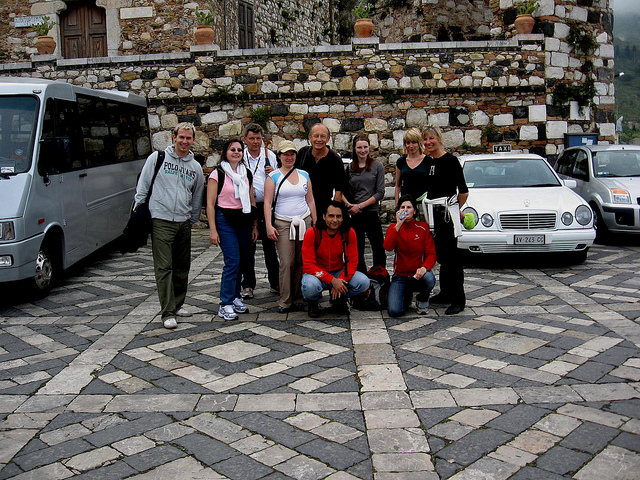Well, my week on the Solitaire II, studying Italian and sailing through the Eolian Islands, had come to an end. Last night our sailing group officially said goodbye, and my departure date from Sicily was fast approaching. Only four more days of discovery were remaining.

The Lungomare di Garibaldi, main thoroughfare of Milazzo
A week on a sailboat does many things, but one thing is for sure – it creates a huge amount of laundry. The entire suitcase that I had taken onto the boat was in desperate need of a good cleansing, so it was time to use the washing machine in the spacious five-bedroom apartment above the Laboratorio Linguistico language school. Claudia, being from Germany, was in charge of selecting the laundry settings on this European machine, and shortly after my dirty clothes and those of two of my shipmates were turning happily in the frontloaded washer. Then we hung up the clothes on the balcony of our bedroom and Lorenzo, our favourite Catholic priest, joined us to sit for a bit outside. After a while he headed off to get his hair cut while Claudia and I met our other shipmates, Franco and Agnieszka, who were going to take us on a tour of Milazzo.

The waterfront promenade with a view of the Castello
Milazzo is a town with a population of about 30,000 people on the northeastern coast of Sicily, located about 50 km from Messina. It has a long history, dating back to Greek colonization as the city of Mylai in 716 BC. Milazzo is located on a narrow peninsula on the Tyrrhenian coastline that protrudes about six or seven kilometers into the sea. The tip of the peninsula is called Capo Milazzo which features a variety of restaurants perched on a cliff above the sea as well as nature areas and an 18th century lighthouse.

A fountain in downtown Milazzo
The downtown of Milazzo is located on the eastern side of the peninsula around a bay and the south side of the bay is characterized by a variety of industrial and refinery buildings. Our local expert Franco explained that Milazzo is quite a popular tourist destination for Italian travelers in the summer, but is not particularly well known internationally. It is a reasonably priced destination, much more affordable than some other extremely popular destinations in Italy.

A freshly caught swordfish
Our apartment at Laboratorio Linguistico is very centrally located at Via Nino Riolo, just steps away from the Chiesa di San Giacomo, dating back to the 15h century, and the Lungomare Garibaldi, the beautiful palm-lined waterfront promenade of Milazzo. Franco took us along the Via Medici towards the fish market which features two rows of fish and seafood vendors, selling a large variety of marine delicacies caught locally. One local fisherman in particular seemed to enjoy the camera and held up several different fish with a big smile while his coworker was watching him with an expression of suspicion. We also saw a huge swordfish, it must have been about two meters long and was staring at us with its silver-coloured empty eyes. Another fishmonger had just a head of a swordfish on display, the body had already been cut up and filleted. Fish markets are always an assault to the senses, fascinating visually, but the smell is a different story.

One friendly fisherman, the other one not so much
We briefly stopped at the municipal tourist office in the Municipio building to get some information on the bus schedules that would take us from Milazzo to Catania for our return flights and were rather impressed by the friendly service that the gentleman behind the counter was providing to us. Now equipped with the knowledge of how we would get to the Catania airport we continued our walk along the Lungomare.

The Castello di Milazzo
The Lungomare is a waterfront promenade, fronted on the eastern side by a long row of attached houses that are several hundred years old, with a paved walkway that is separated from a busy street by a narrow lawn and a fringe of palm trees. On the eastern side is a sandy beach that serves as the starting point for the dozens of fishermen that have their boats permanently parked along the waterfront. The Chiesa di Santa Maria Maggiore forms the northern end of the of the main section of the waterfront promenade, from where things get a little quieter.

Ruins of the old orphanage
Franco pointed out a fascinating classical building that used to be an orphanage, but today lies in ruins. We turned left on Erta San Domenico, a stone-paved road with an interesting pattern that would take us up past a series of steps towards the castle, the “Castello di Milazzo”.

Erta San Domenico, leading up to the Castle
Like all of Sicily, Milazzo has thousands of years of history. Settled since the Neolithic Age, Milazzo has always had a strategic location along the Tyrrhenian Sea, used by the Romans and then the Arabs. The current castle was originally constructed under Norman rule around 1000 AD and later reinforced in the 15th century by Alphonso of Aragon. During the 18th Century and the subsequent Bourbon period it suffered great damage and later became a prison, which it remained until 1960.

The Castello di Milazzo




